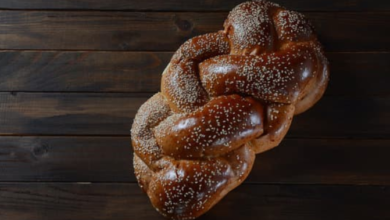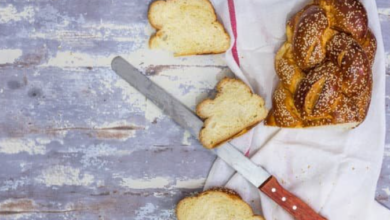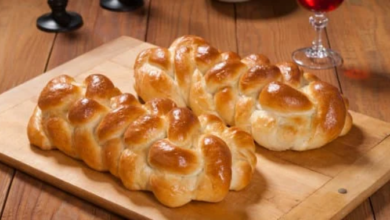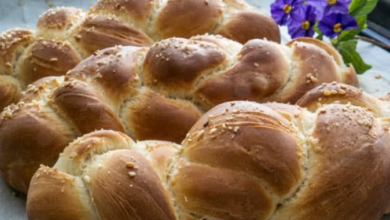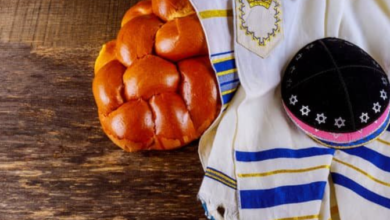Challah Vs. Regular Bread: What’s the Difference?

What To Know
- It is typically made with a rich dough that includes eggs, honey, and oil, resulting in a soft and slightly sweet taste.
- Whether you prefer the intricate beauty and symbolism of challah or the simplicity and versatility of regular bread, embrace the diversity and indulge in the culinary delights that bread offers.
- Challah is not necessarily unhealthy, but it is higher in calories and fat compared to regular bread due to its egg and oil content.
When it comes to the realm of bread, two prominent contenders emerge: the iconic challah and the ubiquitous regular bread. Both have their unique characteristics and culinary applications, sparking a lively debate among bread enthusiasts. This blog post aims to delve into the intricacies of challah vs regular bread, exploring their distinctive features, flavors, and the culinary contexts where they shine.
The Anatomy of Challah
Challah, a traditional Jewish bread, is characterized by its distinctive braided appearance, often resembling a crown. It is typically made with a rich dough that includes eggs, honey, and oil, resulting in a soft and slightly sweet taste. The braiding process adds an element of intricate beauty, making challah a visually appealing centerpiece for any table.
The Simplicity of Regular Bread
Regular bread, on the other hand, encompasses a vast array of varieties, ranging from white to whole wheat and sourdough to rye. It generally has a simpler composition, primarily consisting of flour, water, yeast, and salt. Regular bread offers a versatile base for sandwiches, toast, and various culinary creations.
Taste and Texture: A Matter of Preference
The taste and texture of challah and regular bread differ significantly. Challah’s egg-enriched dough imparts a subtle sweetness and a soft, fluffy texture. Its braided form creates pockets of air, resulting in a light and airy crumb.
Regular bread, on the other hand, exhibits a wider range of flavors and textures depending on the type and ingredients used. White bread offers a mild, neutral taste, while whole wheat bread has a more robust, earthy flavor. Sourdough bread, with its extended fermentation process, boasts a tangy and slightly chewy texture.
Culinary Applications: Where They Excel
Challah is a beloved choice for special occasions and religious ceremonies. Its symbolic representation of unity and abundance makes it a perfect centerpiece for Shabbat dinners and Jewish holidays. Challah’s soft texture and slightly sweet flavor pair well with dips, spreads, and smoked fish.
Regular bread, with its versatility, serves a multitude of culinary purposes. It forms the foundation of sandwiches, grilled cheese, and French toast. Its ability to absorb flavors makes it an excellent accompaniment to soups, stews, and curries.
Nutritional Value: A Comparison
Challah, due to its egg and oil content, is generally higher in calories and fat than regular bread. However, it also provides a good source of protein and carbohydrates. Regular bread, especially whole wheat varieties, offers higher fiber content, which is beneficial for digestive health.
The Perfect Choice: A Matter of Context
The choice between challah and regular bread ultimately depends on the occasion and personal preferences. Challah’s symbolic significance and unique taste make it an ideal choice for special gatherings and celebrations. Regular bread, with its versatility and adaptability, is a reliable staple for everyday meals and culinary creations.
The Bottom Line: Embracing the Diversity of Bread
The debate between challah vs regular bread highlights the rich tapestry of bread varieties available to us. Each type possesses its own distinct characteristics and culinary applications. Whether you prefer the intricate beauty and symbolism of challah or the simplicity and versatility of regular bread, embrace the diversity and indulge in the culinary delights that bread offers.
Top Questions Asked
1. Is challah healthy?
Challah is not necessarily unhealthy, but it is higher in calories and fat compared to regular bread due to its egg and oil content. However, it also provides a good source of protein and carbohydrates.
2. Can challah be made without eggs?
Yes, it is possible to make challah without eggs. However, the eggs contribute to its rich flavor and soft texture, so the resulting bread may have a slightly different taste and consistency.
3. What is the difference between challah and brioche?
Challah and brioche are both enriched breads, but they have some key differences. Challah is typically made with eggs, honey, and oil, while brioche uses butter and milk. Brioche also has a higher butter content, resulting in a richer, more tender texture.
4. Can I freeze challah?
Yes, challah can be frozen for up to 3 months. Allow it to cool completely before freezing, and wrap it tightly in plastic wrap or aluminum foil to prevent freezer burn.
5. How do I reheat challah?
To reheat challah, preheat your oven to 350°F (175°C). Wrap the challah in aluminum foil and bake for 10-15 minutes, or until warmed through.
